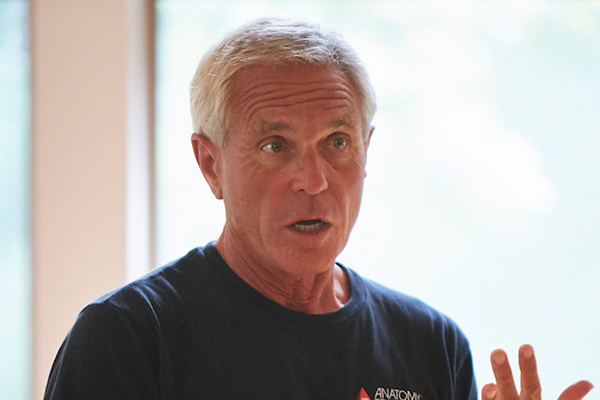
Thomas Myers, Director, Anatomy Trains
The following blog post is sponsored by Anatomy Trains.
How did Anatomy Trains get its start?
While teaching anatomy for the Rolf Institute, I was trying to get the students to get on that “whole is greater than the sum of all the parts” you have to grasp. So, I started saying things like, “See how the serratus anterior feeds into the external oblique—same direction, same layer—how far can you go on that train?”
What started as a game with beginning students developed over the 90s into a system of 12 myofascial meridians. In 1997, I put it into an article, and in 2001, the book was published. I have been totally surprised by how popular this Anatomy Trains map became, not just with massage therapists and yoga teachers but physiotherapists, personal trainers, athletic coaches—and in Asia, even doctors.
In 2005, I started training other teachers, and now we have an ever-expanding platform of teachers and educational offerings for a variety of professions worldwide.
What special opportunities for education does Anatomy Trains offer?
Now, of course, in the time of COVID-19, we’re in the process of collating all our video material and creating both live and streaming online courses for the duration of this ban on touching. You cannot teach manual technique over the internet, but we’re very determined to keep serving the professional public with everything else: fascial research, anatomy, visual assessment, and strategy.
In normal times, I would answer three major special opportunities.
- Dissection: Anatomy Trains offers unique practical dissection courses in Boulder, Colorado, where you get to do a complete dissection of an untreated donor—meaning lifelike movement and color, and no bad chemistry like formaldehyde. Now, dissection is not everyone’s cup of tea, I know, but if you want to change your ideas at a fundamental level about the body you work with—your own and others’—come to one of our dissection classes.
- Online learning: We are rapidly expanding our video and online learning library to include systems anatomy, assessment, techniques, strategies for postural change, homework for clients, and philosophy of practice. While we cannot certify anyone in a technique without in-class mano-a-mano hours, many folks are getting their CEUs and bolstering their eyes and hands via our online webinars.
- New perspectives: We are coalescing a school around the Anatomy Trains map that includes an evolved Pilates mat class for strengthening, stretching, and balancing; another class aimed toward safe and complete training using the Anatomy Trains map as a guide to stability; and a third aimed at specifying yoga-like deep stretches to drive glide between fascial planes. I myself am binding together the latest information on stress and distress management in bodywork, as this is increasing as we live through these “interesting times.”
Are your training courses in-person, online, or a combination of both?
Combination—we maximize the kinesthetic component during our in-class hours by exporting what can be done audiovisually to the online sections. And that’s being tested in the real world right now, of course, with every university taking up the challenge to get stuff online we never would have thought of putting online before. Of course, we cannot monitor students’ grasp of the fascial release techniques, so there will be catch-up hands-on classes when we can have them.
Meanwhile, we’re moving to online education in a big way—just recently we put out a video course on strategizing our three-session Structural Integration series, and we’ve just come out with a really good (if I do say so) experiential anatomy course for yoga teachers that is definitely fun for massage therapists too.
To learn more, visit www.anatomytrains.com.